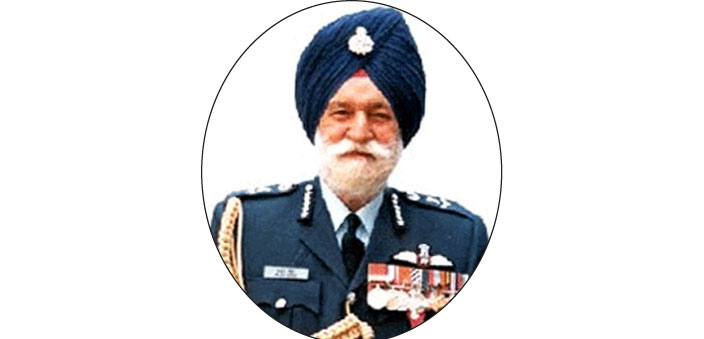Most distinguished Air Chief Marshal (1919-2017)
Arjan Singh was born on 15 April 1919 at Layalpur, and was educated at Montgomery. He was selected for the Air Force while studying at the college and completed his training at the Royal Air Force (RAF) College at Cranwell, UK. He was commissioned in December 1939 and was posted to No 1 Squadron, Indian Air Force (IAF). The unit was equipped with Westland Wapiti aircraft and was tasked to support ground operations against hostile tribes in Waziristan on the North Western border. After a brief stint with No 2 Squadron, he returned to No 1 Squadron which was by then been equipped with Hurricane aircraft. The squadron moved to Burma on 1 February 1942 and Squadron Leader Arjan Singh took over the command of the unit in February 1944.
The squadron was engaged in the task of photo-reconnaissance and support for army operations and achieved high standards of courage and efficiency, which was well appreciated by Air Vice-Marshal Stanley Vincent. On one flight, they noticed a concentration of Japanese troops and river crossing equipment. The timely information provided the likely crossing place selected by the Japanese and it changed the course of history. On another occasion Arjan Singh observed troops on a hill overlooking the airfield, in strange uniform. On taking a closer look, he recognised them to be Japanese soldiers. He immediately took the entire squadron to attack them. The relentless action by his squadron turned Japanese retreat into a rout. Admiral Mountbatten flew to the site to personally pin the DFC (Distinguished Flying Cross) on Arjan Singh. He was the first Indian pilot to be so honoured by the Supreme Allied Commander. The citation read:
“Squadron Leader Arjan Singh is a fearless and exceptional Pilot, with a profound knowledge of his specialised branch of tactical reconnaissance and he has imbued those under him with the same spirit. The success of No. 1 Squadron Indian Air Force reflects the greatest credit on him.”
He attended Staff College,UK, Joint Services Staff College, UK, and Imperial Defence College, London. He was head of operational command in the rank of Air Commodore from 1949 to 1952, and took over as Chief of AIR Staff (CAS) on 1 August 1964 in the rank of Air Marshal. He had flown over 60 types of aircraft including pre-World War II bi-planes to Gnats and Super Constellations. He almost faced a court martial for flying low in Kerala to raise the morale of IAF crew. He maintained that such feats were essential for the making of a fighter pilot. Pakistan launched a major attack by armour on 1 September in Akhnur sector. It posed a severe threat to India and the Army requested for air strikes against the Pakistani tanks.
The strike by the IAF shattered the Pakistani tanks. It is a matter of great credit that the IAF pilots faced the enemy’s superior planes with courage. General war broke out on 6 September. The Gnat fighters of the IAF gained the reputation of being ‘Sabre Killers’ even though the Sabres were technically superior. A person of few words, soft spoken and amiable, he was a man of firm action. He did not hesitate to dismiss three senior officers for poor performance in the 1965 War. They were just directed to request for retirement. During his tenure as CAS, the IAF was equipped with new generation of supersonic fighters, strategic reconnaissance aircraft and assault helicopters.
In recognition of his leadership and service to the country, he was promoted to the rank of Air Chief Marshal, the only CAS to hold that rank. He was also awarded the honour of Padma Vibhushan. He retired on 1 August 1969. After retirement he was appointed Ambassador to Switzerland in 1971, High Commissioner to Kenya in 1974, and Lt Governor of Delhi in 1989. He passed away on 16 September 2017 at the Army Hospital, Delhi, and his last rites were conducted at Delhi with full state honours including a fly past.

